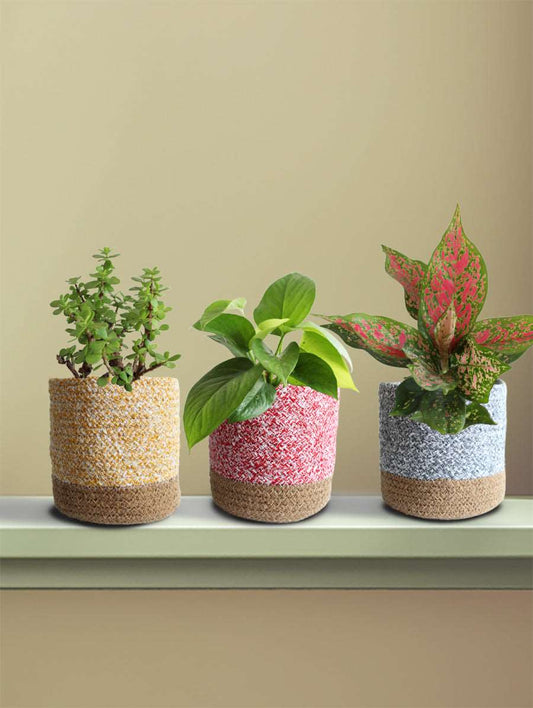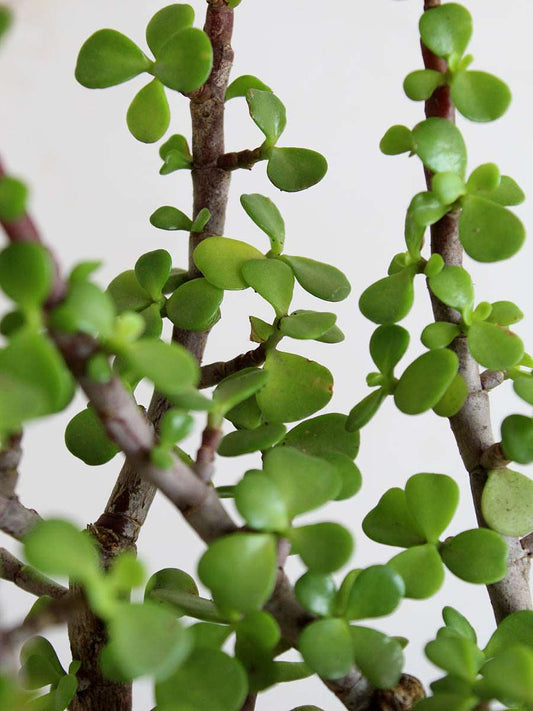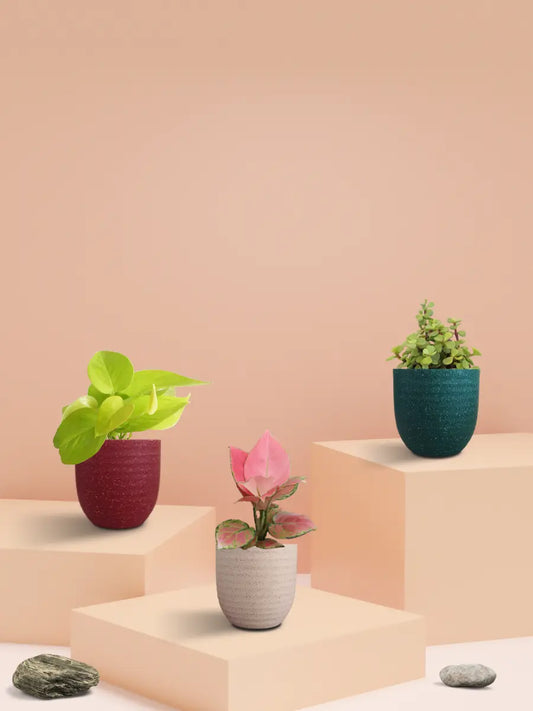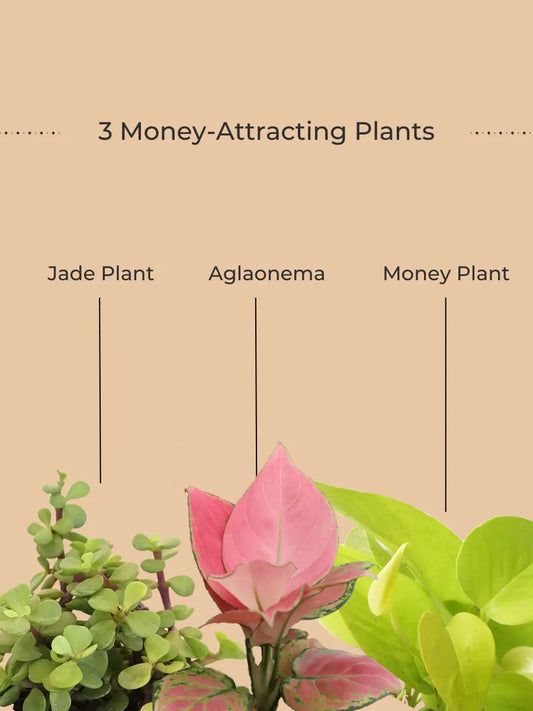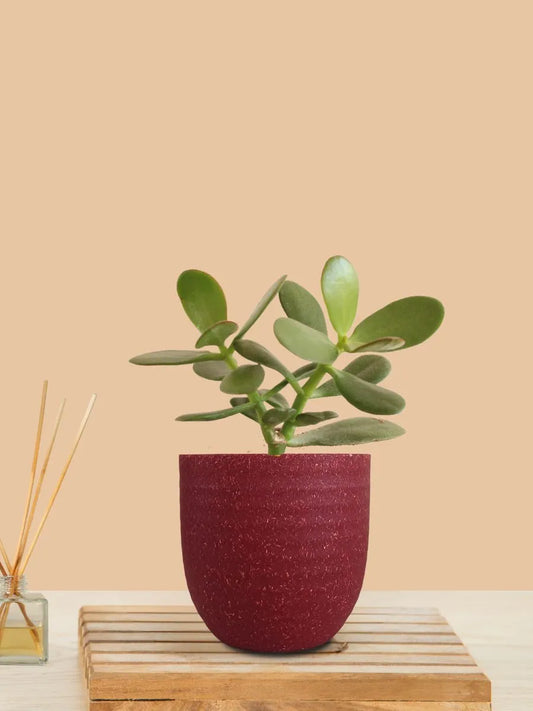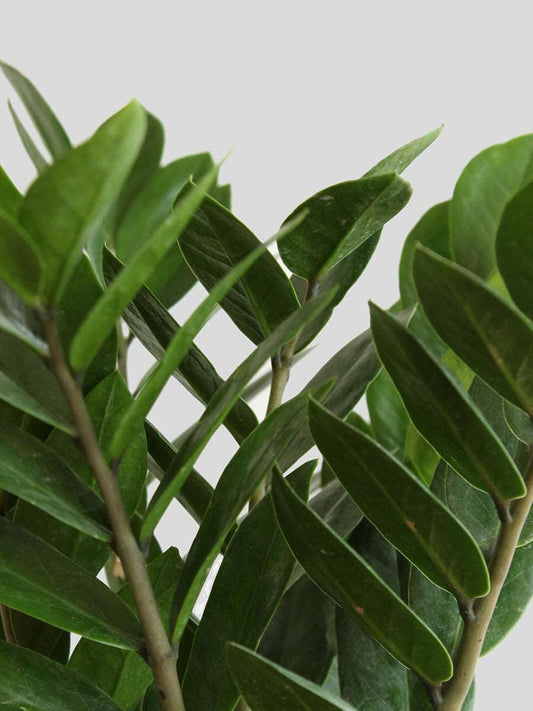
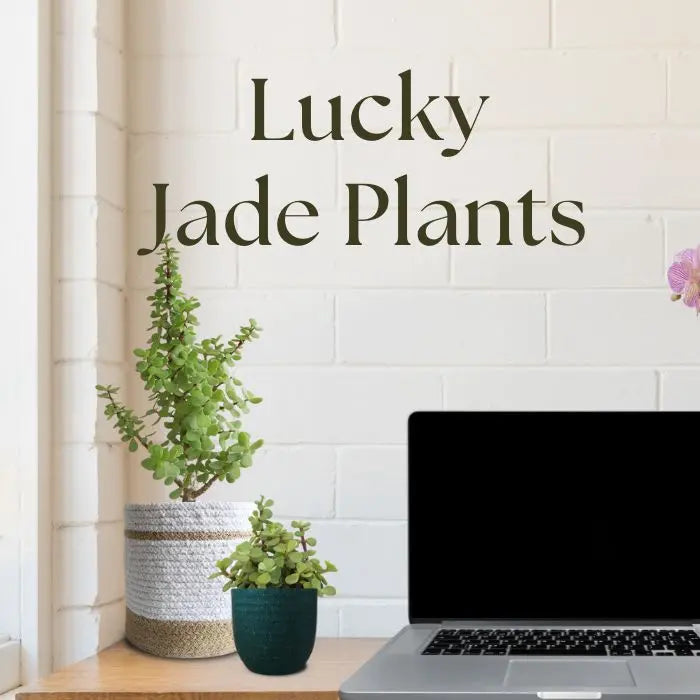
-
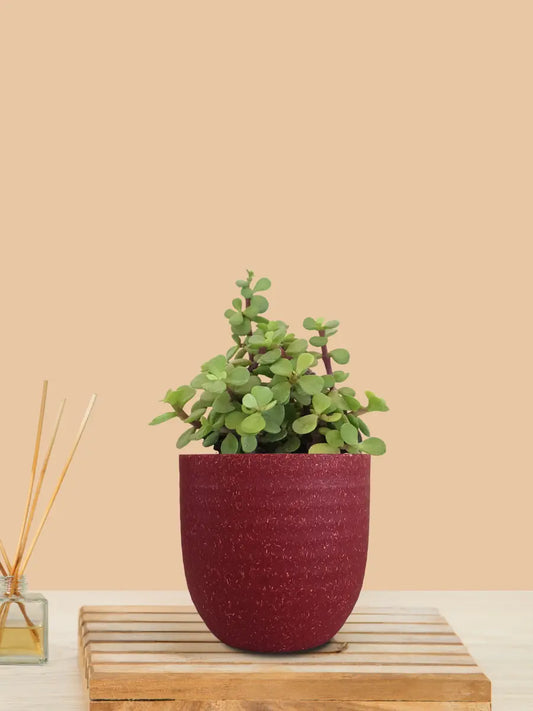
 20% Off
20% OffJade Plant (Small) in Eco Pot
Regular price ₹ 399Regular priceUnit price per₹ 499Sale price ₹ 399Sale -
Goodluck Charm Easy Care Plants Combo
Regular price ₹ 2,344Regular priceUnit price per₹ 3,349Sale price ₹ 2,344Sale -
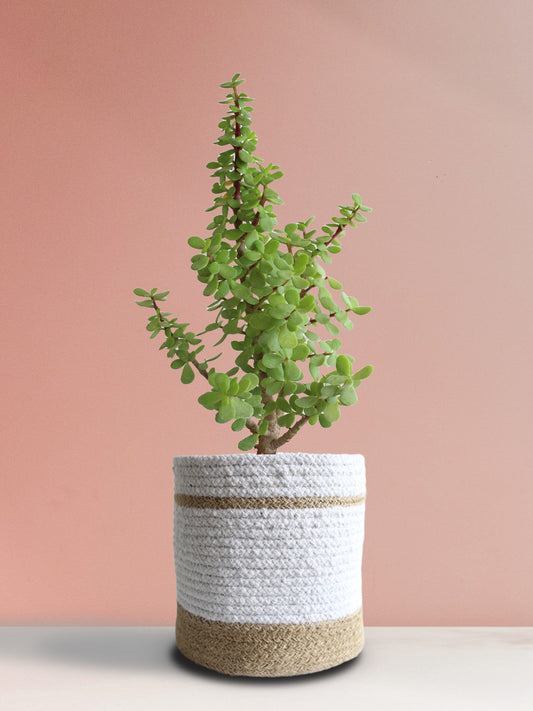
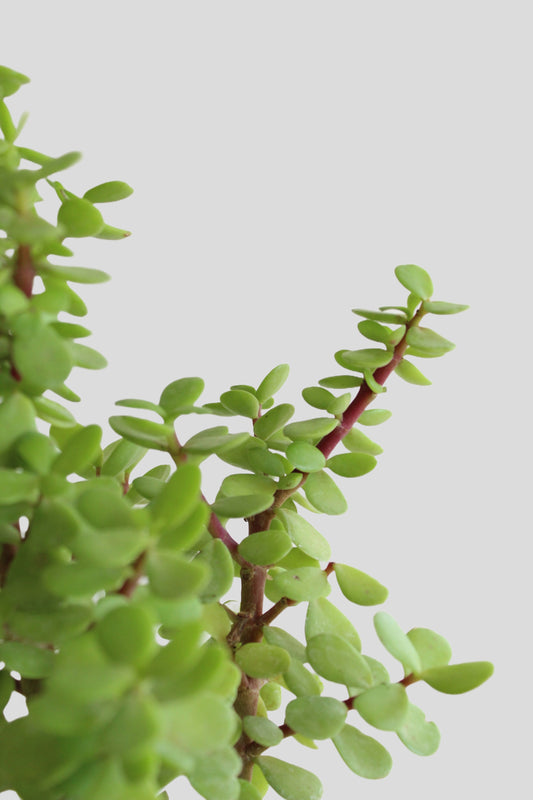 40% Off
40% OffJade Mini (Large)
Regular price From ₹ 659Regular priceUnit price per₹ 1,099Sale price From ₹ 659Sale -
Money Attracting Plants Combo (Small)
Regular price ₹ 1,274Regular priceUnit price per₹ 1,699Sale price ₹ 1,274Sale -
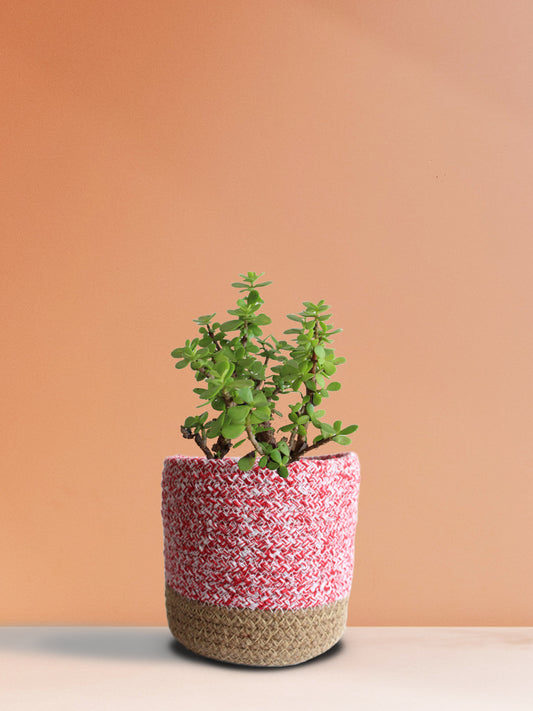
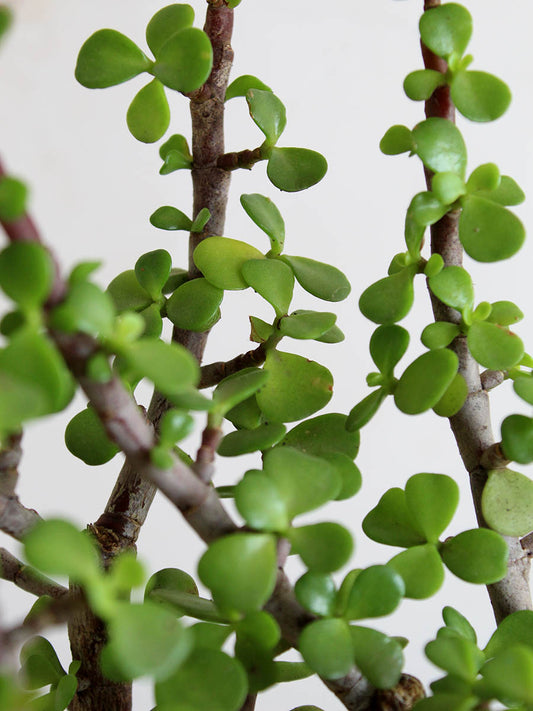 40% Off
40% OffJade Mini (Medium)
Regular price From ₹ 359Regular priceUnit price per₹ 599Sale price From ₹ 359Sale -
Crassula Ovata Plant (Small) in Eco Pot
Regular price ₹ 439Regular priceUnit price per₹ 549Sale price ₹ 439Sale -

 30% Off
30% OffIndoor Desk Duo
Regular price ₹ 1,644Regular priceUnit price per₹ 2,349Sale price ₹ 1,644Sale -
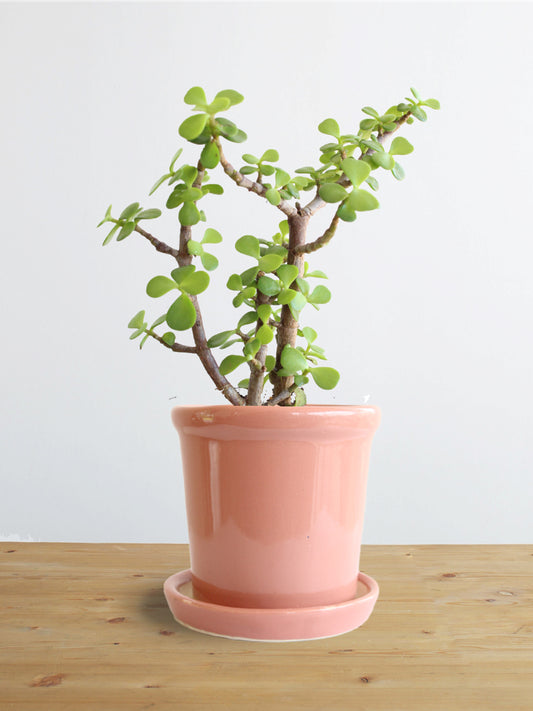
 20% Off
20% OffJade Mini (Small)
Regular price From ₹ 599Regular priceUnit price per₹ 749Sale price From ₹ 599Sale -

 30% Off
30% OffMoney Maker Duo
Regular price ₹ 1,434Regular priceUnit price per₹ 2,049Sale price ₹ 1,434Sale -
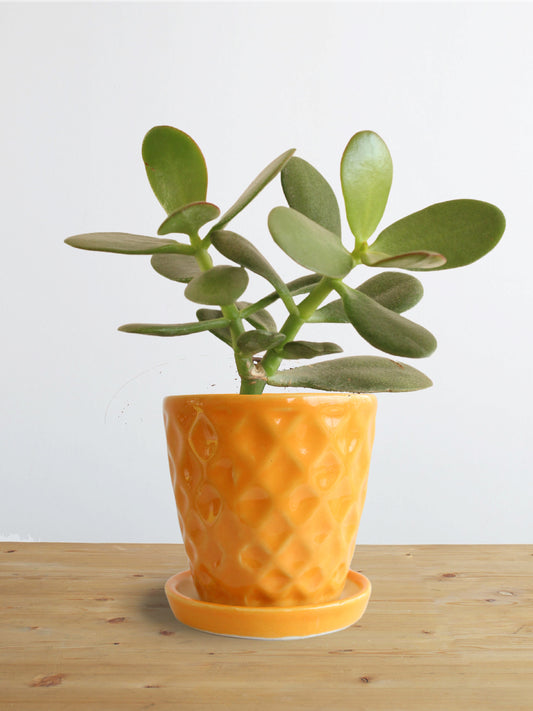
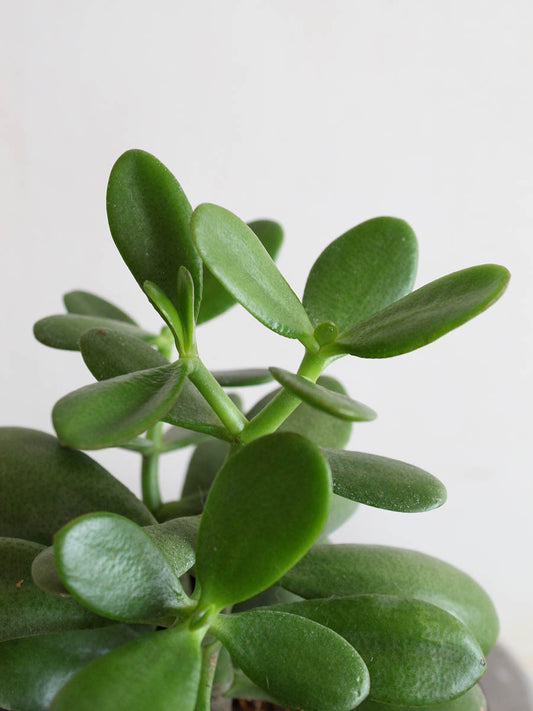 20% Off
20% OffJade Plant (Small)
Regular price From ₹ 599Regular priceUnit price per₹ 749Sale price From ₹ 599Sale -

 30% Off
30% OffNo Fret Duo
Regular price ₹ 1,364Regular priceUnit price per₹ 1,949Sale price ₹ 1,364Sale -

 Sold out
Sold outJade Plant (Medium)
Regular price From ₹ 479Regular priceUnit price per₹ 599Sale price From ₹ 479Sold out
Buy Jade Plants Online
Buy a Jade plant online to create a relaxing environment in your home or place of business. Whatever room you're trying to decorate indoors, this plant will look beautiful. Not only that, but the jade plant's dark green, gorgeous leaves are also decorative. Additionally, this tropical plant has a lengthy history of being grown beside various residences and businesses because of its symbolic meaning of bringing good luck.
Origin and History of Jade Plants
Jade's plant is scientifically referred to as “Crassula ovata." The succulent plant is native to South Africa, particularly in the regions of KwaZulu-Natal, the Eastern Cape Region, and Mozambique. It is also known as the lucky plant, money plant, or money tree. It is also sometimes called the money tree, but Pachira Aquatica also claims that title.
The jade plant is an extremely drought-resistant evergreen plant that was discovered in South Africa in the 17th century. It belongs to the Dogbane family (Apocynaceae) and is grown as an ornamental plant in South African gardens. It is also used in a variety of other applications. The South African jade plant is known for its rapid growth rate and large leaves. It has semi-woody stems but mostly soft, succulent stems.
Common Varieties of Jade Plants
There are nearly 300 different species of Jade plants. The most frequent type of jade plant seen in homes is Crassula Ovata. However, within this species, there are several remarkable variations to explore:
- Crassula Ovata ‘Crosby’s Compact’: ‘Crosby's Compact’ is also known as 'Crosby's Dwarf', 'Crosby's Red', or 'Red Dwarf Jade Plant'. This variety's leaves are smaller and usually red. Although smaller than other types, the branches can look microscopic.
- Crassula Ovata ‘Monstruosa' (syn. 'Cristata', 'Gollum', 'Hobbit'): 'Monstruosa' is a shrubby cultivar with trumpet-shaped, skimpy branches that can grow up to 90 cm (3 ft) tall and 60 cm (2ft) wide. This plant has reddish-coloured tubular leaves and small flowers that look like stars. The flowers can be white or pinkish-white. Over time, this succulent grows a thick trunk that resembles a small tree. 'Monstruosa' needs well-drained soil, regular watering, and a sunny, airy spot in your home. This succulent thrives in partial shade or a few hours of sunlight. Some common names for this plant are "Spoon Jade," "Hobbit Jade," "Gollum Jade," "ET's Fingers," "Finger Jade," "Trumpet Jade," and "Ogre Ears".
- Crassula Ovata 'Tricolour': 'Tricolour' is a slow-growing, branching shrub with thick stems and round, variegated green leaves that are creamy yellow and white. Even though it tolerates drought, it needs occasional watering in summer and mostly hibernates without water in winter, unless grown in a pot. The variety is known as Crassula ovata, 'Lemon & Lime'.
- Crassula Ovata "undulata": A type of plant known as "undulata" has leaves that are curved or wavy alike.
Interesting Facts about Jade Plants
Buying a Jade Plant? Here are some super interesting facts about Jade Plants:
- Jade plants are succulents with thick, lustrous, smooth leaves that grow in opposing pairs along the branches and often seem vivid jade green or yellow-green. When exposed to a lot of sunlight, some of the leaf margins may turn red.
- With the correct care, attention, and conditions, jade plants can even produce small, exquisite white or pink, star-shaped blooms.
- Bonsai enthusiasts also often choose “Jade plants”. Miniature bonsai jade plants are a low-maintenance alternative to traditional jade plants. They are formed by directing them to grow in certain containers. They are a great alternative to large jade plants if you have little space.
- In Asian culture, jade plants are revered as symbols of good luck and prosperity. They are also considered to bring positive energy. Ancient Chinese wrapped succulent jade plant leaves with scarlet ribbons for good luck because they looked like ancient jade coins. Hence, the plant got its name, "Jade Money Plant".
- Jade plants are well-known for being both gorgeous indoor plants and symbols of luck. Their large, emerald green or deep ruby red leaves symbolise wealth and success, making them ideal for corporate gifting in small businesses and home offices.
Benefits of the Jade Plant
There are tons of benefits of having a Jade Plant at home. Here are the top advantages that a Jade Plant offers:
- Jade Plants are low maintenance plants: Jade plants are hardy indoor plants that thrive while neglected, making them ideal for those with hectic schedules or those beginning out with their first houseplant.
- Ornamental Benefits Of Jade Plants: Jade plants are known for their versatility, elegance, and style, which have many ornamental uses. Furthermore, jade plants are appealing due to their glossy, dense, smooth, tree-like leaves. They are the ideal choice for adding a touch of nature to any space in the home or office.
- Jade Plants Enhance Indoor Air Quality: Like Pothos and other air-purifying plants, Jade plants are efficient at cleaning the air, helping to remove toxins such as benzene and formaldehyde. This makes jade plants an excellent addition to the home, as they can contribute to better overall air quality and a healthier living environment.
- Jade Plants Stimulate Mental Wellbeing: Researchers claim that caring for indoor plants, including jade plants, can provide tranquillity and mindfulness. These provide a form of horticulture therapy, reducing anxiety and improving mood in the process.
- Symbolic Benefits of Jade Plant: According to Feng Shui and Vastu Shastra, jade plants are commonly referred to as "Lucky Plants," "Dollar Plants," or "Money Trees" because of their round leaves that resemble coins—symbolising prosperity and wealth.
- Jade Plants are Ideal for Gifting: Jade plants are symbolic of “luck and wealth,” which makes them unique and memorable thoughtful gifts (and great for return gifts too). One of the benefits of giving plants like jade is that they grow and blossom wonderfully over time, creating a lasting reminder of the giver's affection when properly cared for.
Things to Consider Before Buying Jade Plant
Before buying a Jade plant, consider the following things:
- Gardening Skills: Plan to buy jade plants according to your schedule or gardening skills.
- Care maintenance: The jade plant is known for its low maintenance requirements. However, this does not mean it can thrive without any care. To keep your jade plant healthy and blooming, you should follow some basic maintenance guidelines.
- The Furry Connection: Place to put jade plants away from pets because they can be toxic if consumed. Do not allow your pet to get too close to a jade plant.
- Style You Want: Which style do you choose for your home: conventional, colourful, or whimsical?
Care Guide for Jade Plant
The following are some maintenance guidelines for Jade plants:
- Lighting Guide for the Jade Plant: Jade plants thrive with four to six hours of direct sunlight or in a medium-shaded position with bright lighting. Insufficient light leads the plant to become weak and leggy.
- Fertiliser Requirements of Jade Plant: Minimal fertilisation is necessary for the growth of jade plants. However, overuse can harm the plant's roots, leaving it susceptible to many illnesses.
- Watering Routine of the Jade Plant: Like all indoor plants, monitor the jade plant's watering needs based on its season and temperature. However, jade plants store water in their leaves and stems, so they need less water than most plants. Also, they've adapted to harsh desert environments. During the summer months, it requires a little more water, and in a very dry climate, spritz it with clean water twice a month.
Additionally, the jade plant is sensitive to overwatering during its growth and cold seasons. Excessive water can cause a jade plant’s leaves to drop and its roots to rot. - Soil preparation for the jade plant: Make sure the soil of the jade plant is not too compacted and drains properly as well.
- Temperature and Humidity Requirements of the Jade Plant: Jade plants prefer temperatures of 16-32°C. Move the plant away from air conditioning vents and cold drafts. Furthermore, jade plants tolerate typical household humidity levels and do not require excessive humidity. However, sprinkle or maintain a small container of water near jade plants to keep the air somewhat humid.
- Shaping and Pruning of Jade Plants: Pruning your jade plant regularly helps promote new growth while also maintaining its shape.
- Jade Plant Regular Inspection for Pests: Problems with pests, including small, white pests or fine webs, are possible. To avoid it, thoroughly inspect the plant's leaves and stems for signs of these issues and treat them by using pesticide soap or neem oil to tackle the problem.
- Toxicity Concerns of Jade Plant: Jade plant leaves' toxins can cause stomach aches, abnormal heartbeats, and other problems, despite their unknown composition. Jade plant venom is minimal, but crassula can cause fatal stomach troubles.
- Propagation of Jade Plants: The jade plant is easily propagated from a single leaf or twig. Propagation can be accomplished using both leaves or any twig in which both rounded and circular leaves can grow. As a result, the jade plant has a simple reproduction process. A jade plant leaf or twig, as well as two additional leaves or many twigs, can be used for this purpose. It is easier to grow two leaves than it is to cut two leaves from a jade plant. In short, all cuttings can be grown on a jade plant.
Jade Plants for Gifting
Jade Plants are Great Return Gifts - Small and Easy to Carry
Jade plants have a variety of leaf patterns, colours, and textures. Their versatility, variety, and lightweight make them ideal gift options for special occasions.
Jade Plants are a Symbol of Good Luck
The jade plant symbolises luck, growth, and wealth, making it an ideal gift for various occasions, including housewarming, birthdays, anniversaries, and more.
Jade Plants are Easy to Care for and are Long-Lasting
A jade plant is an excellent gift for a plant enthusiast due to its long life, low maintenance requirements, and adaptability. It grows indoors or outdoors, and it produces a stunning display when it blooms.
Vastu and Feng-shui Tips for Keeping Jade Plant
People from various cultures historically considered the jade plant a symbol of fortune and prosperity due to its coin-shaped leaves. Nevertheless, in Feng Shui terminology, it's a matter of personal belief.
Best Placement for the Jade Plant:
- Keeping Jade Plant in East Direction: According to Feng Shui, potted jade plants in the east of your living area promote relationships, harmony, health, and new ventures.
- Keeping Jade Plant in South-East Direction: Placing a jade plant in the southeast corner of your home (the corner of wealth and prosperity) will bring you wealth and luck.
- Keeping Jade Plant in West Direction: Jade plants in a western direction in an enclosed space promote strong production and creative thought.
- Keeping Jade Plant in the Entrance: Placing a jade plant in your home's entryway brings good fortune and wealth. Here is a list of best plants for Entrance as per Vastu.
- Keeping Jade Plant on a Desk at Workspace: Jade plants also enhance your workspace, whether they are placed on your desk, in the reception area, or any office room. Jade plants provide you with a boost of positivity, success, and good fortune in your work life. Hence, jade plants are known to be excellent office plants.
- Other Directional Tips for the Jade Plant: Feng Shui experts recommend planting jade plants in the far northwestern zone to attract mentors, teachers, and helpful friends. Also, they advise against placing your jade plant in the bedroom or bathroom. Scientifically, putting your jade plant in the bedroom or bathroom improves air quality.
Why Choose Greenkin to Buy Jade Plant
Greenkin offers a large selection of stunning jade plants that can be delivered right to your home. Our user-friendly online shopping platform allows for easy buying of things, prompt delivery, and guaranteed quality every time you place an order. We offer different varieties and sizes of Jade plants in various sizes (small, medium, and large) in eco-friendly pots. Also, you can choose a pre-made combo of plants where jade plants are combined with other plants to create the perfect aura. So along with indoor plants, buy a beautiful jade plant for your home today!
FAQ
The name "Jade" comes from the plant's leaves, which often resemble the jewel-like green jade stone. It's believed that the round, coin-shaped leaves bring financial luck.
Jade plants are succulents with thick, fleshy growth. They are native to South African and Mozambican. They belong to the Crassulaceae family. They are well-known for their capacity to thrive in arid environments.
Most people associate jade plants with wealth and luck. Some communities regard them as symbols of friendship and success. Moreover, their longevity symbolises growth and renewal.
People have kept jade plants as houseplants for millennia. These plants are extremely prominent in Asian cultures due to their significance. Gifting jade plants for housewarmings and new company launches symbolises a wish for a friend or family member to succeed.
Jade plants prefer indirect light. Although, they benefit from several hours of direct morning sun, severe afternoon sun can scorch their leaves.
Being succulents, jade plants can survive in arid environments. Wait to water until the soil is dry. Jade plants are particularly susceptible to overwatering.
Use a well-draining soil combination designed for succulents or cacti. Select permeable terracotta or clay pots to avoid root rot.
Fertilise your jade plant periodically in spring and summer. It is recommended that you use a diluted, balanced liquid fertiliser.
Cutting back jade plant growth promotes healthier, more vibrant bushes and discourages overgrowth.
Jade plants come in many varieties (or species). For example, there are distinguishing characteristics in Crassula ovata, Hummel's Sunset, Gollum, Variegated Jade, and Tricolour. They have unique tubed leaves, creamy or yellow variegation, and splashed green, white, and pink leaves with red and gold margins.
According to Vastu Shastra, jade plants bring prosperity and positive energy. Thus, those seeking financial or other luck employ these indoor plants. Many households and businesses place them near the entrance. Southeastern is the best direction for these plants.
Yes, jade plants are popular gifts for housewarming, birthdays, retirements, and business launches. The emphasis on prosperity and strong growth makes them thoughtful gifts.
Jade plants add greenery and beauty to a room. Small jade plants as foliage look lovely on desks, shelves, and windowsills. Large, grown jade plants will amaze your room corners. For a unique look, have your florist train your jade into a bonsai.
Incorrect watering schedules are the main cause of jade plant leaf fall. Underwatering, poor lighting, temperature changes, and pests are major causes of leaf loss. Examine the plant and your care habits to determine the cause.
Yellow leaves may indicate overwatering. Too much water can colour leaves dotted yellow. Also, most houseplant root damage is from overwatering. Perhaps the plants have taken up too much water due to the high heat. Always water the plant again when the top inch of soil is completely dry.
Spots or discolouration on jade plants has several reasons. First, fungal infections cause soft, discoloured patches. Second, mites and caterpillars can infest, either by themselves or by webbing. Lastly, a mottled appearance is an indication of sunburn on a jade plant. To prevent discolouration, monitor and fix these issues.
Leggy jade plants usually lack sunlight. Move your jade to a brighter spot to fix this. You may also intend to prune lengthy stems to make them bushier.
Jade plants develop slowly, depending on light, water, and container size. Well-maintained plants grow two inches annually.
There are two jade plant propagation methods. The first method is to cut a healthy plant leaf, dry it, and plant it in suitable soil. Another is stem cutting, which takes a little longer before being planted in a well-aerated, well-drained potting mix.
Make sure a jade plant grows well, gets enough sunlight, and has cooler nighttime temperatures for blooming. Jade plants kept indoors rarely bloom.
Repot jade plants only when the roots fill the container, usually every 2–3 years. Use high-quality, well-draining potting mix and larger pots.
Yes, jade plants thrive in outside landscaping in USDA Zones 9–11. They still need well-aerated soil and protection from afternoon UV rays.
Yes, jade plants are good bonsai. You may create beautiful bonsai-style jades by cutting them on a regular basis, shaping their branches with wire, and keeping them in smaller pots or containers.
Yes, jade plants are toxic. Its ingestion can be mildly harmful to people and animals. Calcium oxalate crystals in these plants can irritate the mouth, stomach, and skin. Keeping these plants away from dogs and children is recommended.
If you suspect your pet ate a jade plant, consult your vet. Their symptoms may include excessive salivation, vomiting, or gastrointestinal distress.
The tiny pores employed by plants to exchange gases are likely stomata. This is typical of a healthy jade plant.
Yes, a succulent jade plant's leaves can turn red in intense light, especially at low temperatures. This reaction, however, is not cause for concern. Rather, it is a common stress response.
As succulents, jade plants may spend weeks without water. For longer trips, have someone water them once in a while.
First, stop watering the plant and let the soil dry out. If root rot has occurred, move the plant to fresh, arid soil and remove fragile, damaged roots.
Yes, but slowly! Jade plants must adjust to sunlight. Start them in shaded regions and gradually move them to sunny spots over two weeks.
With appropriate care, these succulents can thrive for decades and be passed down. Some specimens reportedly lived over a century under optimal conditions.
In certain cultures, placing a coin on the jade plant enhances its magical and miracle-making powers.
Jade plants can have white fly, scale, and fungal infestations. Scales are brown, earthquake-like parasites, whereas white flies are tiny, white, fuzzy parasites. Excess watering might cause fungal diseases. Replant in dry soil after applying neem oil or insecticidal soap to contaminations.
Jade plants convert carbon dioxide into oxygen, despite not being the best air purifiers. Every plant, big or small, purifies the air.
Yes, jade plants, like other succulents, prefer rainwater over tap water because it is slightly acidic and chemical-free.
Yes, the jade plant, which originated in arid areas, thrives in most houses' humidity. To avoid fungal infections, keep the area from becoming too humid.
Yes! Because the jade plant tolerates parched soils, it's easy to move from potting in soil to hydroponics. To avoid root rot, use a drainage-enhancing hydroponic medium and carefully change the nutritional solution.
The poisonous characteristics of jade leaves make them unsuitable for internal usage, despite a few historical therapeutic uses. According to some claim, some people get relief from minor skin irritations by applying crushed jade leaves to the skin.
You can gently twist many jade plants in the same container using the pliable young branches for a distinctive look. As they develop, these twined stems will naturally grow into a single stem.



